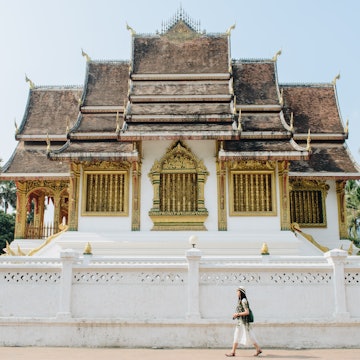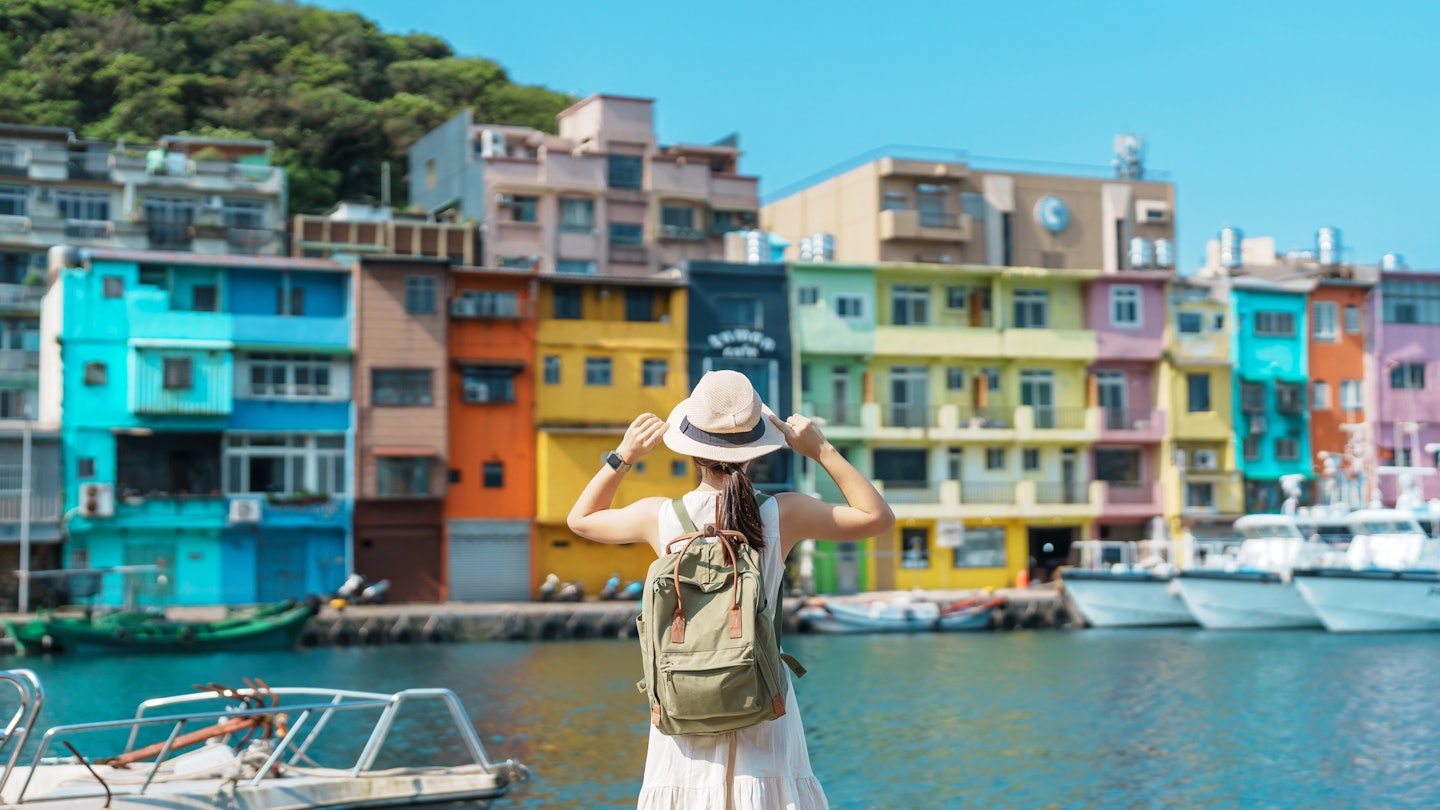

Admiring the bold colors of Zhengbin Fishing Harbor is just one way to spend time on a day trip from Taipei © Panuwat Dangsungnoen / Shutterstock
Within the dense forests that encircle the colorful Taiwanese capital, the beauty of rural Taiwan awaits, made accessible by Taipei’s ultra-efficient public transport system.
Along with a full spectrum of green spaces, cultural heritage abounds, from the steep alleyways of Jiufen Old Street to the old-world Pingxi railway. Read on to discover our favorite day trips from Taipei.

1. Hike all day long in Yangmingshan
Best for fresh air and views
The sheer number and range of hiking opportunities near Taipei will leave you breathless, as will the area's countless parks and reserves. Yangmingshan National Park is one of the most accessible natural preserves, lording over Taipei City with lush peaks coated in silver grass and an extensive network of trails winding through meadows and pastures.
There are 10 hikable peaks at Yangmingshan and if you have 11 hours to spare, you could try climbing them all in one day. For a more relaxing day, try for just one or two peaks – perhaps Mt Qixing’s main and east peaks – followed by a meeting with water buffalo on the Qingtiangang Grassland, geothermal encounters at the Xiaoyoukeng geological park or lily picking at Zhuzihu (possible from February to May). Beitou Hot Springs is another nearby attraction and its steaming baths are all the more appealing after a full day of hiking.
There are several ways to climb 1120m (3675ft) Mt Qixing – the meandering 2.4km (1.5-mile) Miaopu trail starting near Yangmingshan Visitor Center follows a stone-paved path, with signs in Mandarin and English; signs along the route highlight other attractions such as Menghuan Pond and the Lengshuikeng natural springs, allowing you to extend your trip depending on energy levels.
How to get to Yangmingshan: To reach the visitor center, hop on shuttle bus 260 from Shimin Boulevard behind Taipei Main Station and alight at Yangmingshan Bus Terminal (30NTD/US$1, one hour).
From the bus terminal, walk back to the main road and head uphill; look for a sign on your right marking the path to the visitor center. Pick up a detailed map here (or get human advice!) to locate any trails you wish to try. After completing your hike, the 108 bus can drop you back at the visitor center to catch the 260 bus returning to Taipei City.

2. Enjoy quirky old mining towns and waterfalls on the Pingxi Line
Best for railway nostalgia
Originally constructed to connect a series of coal mining towns during the Japanese occupation, the charming Pingxi railway line is less than an hour from Taipei. This 12km (7.5-mile) single-track railway runs parallel to the Keelung River and stops at a number of slow-moving villages that are rich with mining heritage, spectacular natural attractions – and cats!
Houtong Cat Village will win you over early on, so pause for some quality time with the dozens of docile kitties that sunbathe on the steps and corrugated roofs around the village. You can also visit the coal mining museum (and ride a handcar into the tunnels), followed by a coffee in a cutesy cat-themed cafe while you wait for the next scheduled train – they usually run every hour.
Sandiaoling and Shifen are two competing waterfalls on the Pingxi Line; the former is worth visiting for forested hiking trails leading to swimmable pools; the latter is considered the best option for mindblowing views. The Sandiaoling Waterfall Trail is a half-day trip in itself, linking the Hegu and Motian cascades and Pipa Cave via a suspension bridge and nature trail. The 40m (131ft) Shifen Waterfall is considered Taiwan’s most scenic cascade and it has the added bonus of an adjacent "old street" of vintage houses.
The penultimate stop is Pingxi, the mining town that gave the railway its name, known for its nostalgic old street and Sky Lantern Festival, held every February, when nearly 100,000 visitors paint their wishes onto paper lanterns and release them into the night sky. At the final stop of Jingtong, you can stroll along tracks lined with souvenir stalls, stands serving sizzling Taiwanese sausages, and heritage buildings.
Concerns about the environmental impacts of sky lanterns are on the rise, with many counties in Taiwan banning them entirely. Releasing sky lanterns in Pingxi is legal as long as visitors follow a few rules established by the city’s government. If you choose to participate, there are a few ways you can minimize your environmental impact, such as collecting and recycling debris at Sky Lantern Shell Recycling Stops throughout the city.
How to board the Pingxi Line: The Pingxi Line is an easy day trip from Taipei and it's easy to extend the trip with an overnight stay in wildly popular Jiufen village. Taiwan Railway (TRA) trains to Ruifang Station run from Taipei Main Station (from 50NTD/US$1.70, one hour), at which point you can transfer easily to the Pingxi Line.
A day ticket for unlimited travel on the Pingxi Line costs only 80NTD (US$2.75), making it one of the all-time best cheap trips from Taipei. On weekends, the small train can get quite packed, especially when returning to Ruifang at the end of the day. Consider coming on a weekday or start early to avoid the worst crowds.

3. Get hot and steamy in Wulai District
Best for hot springs and hikes
One of the top romantic getaways near Taipei, Wulai District gets its name from the Atayal word for the hot springs for which this Indigenous town is renowned. Despite some commercialization, Wulai retains a certain authenticity – the mountain valley is cut off from the rest of Taiwan and exists in harmony with the verdant mountains surrounding it.
Most people who come here stay overnight at a Wulai hot springs resort, some of which are bookable by the hour for day-trippers. It's also possible to bathe in hot springs for free next to the Wulai River, allowing you to save your money for a visit to the Wulai Atayal Museum, a tram ride or the gondola trip to the Yunshien Amusement Park. Along the way, pick up Atayal snacks such as wild boar, stuffed bamboo tubes and millet wine.
Travelers wishing to get off the beaten park have myriad options, including heading beyond the red Nanshi suspension bridge on looping hiking trails towards Wulai Falls or climbing straight up Big Knife Mountain. Rambling along the rocky Laka Trail or hiking through the emerald-hued Mini Gorge is particularly rewarding. River tracing (like canyoning), swimming and camping are more options for outdoor fun.
How to reach Wulai: The simplest route to Wulai from Taipei is to board the 1601 bus from Xindian MRT Station (40NTD/US$1.40, 30 minutes). Taxi drivers wait around the metro station looking to ferry tourists to Wulai for a fair rate, so if the bus is full, consider teaming up with other travelers and sharing the ride.

4. Bathe in a forest glade at Manyueyuan National Forest
Best for rural serenity
Japan – Taiwan’s close neighbor – may have coined the term shinrin-yoku (forest bathing), but this custom can also be enjoyed in the dense forests surrounding Taipei. About 55km (34 miles) from the Taiwanese capital in Sanxia District, Manyueyuan National Forest is one of the closest places to Taipei for an arboreal bathing session and it's famous for its waterfalls set in woodland along a subtropical creek, with lots of potential bathing spots.
Day trippers to Manyueyuan can tackle a 10km (6.2-mile) loop trail that crosses over Beichatian Mountain, passing through ancient stands of forest. Alternatively, you can follow a flat, paved trail along the Dabao River for possible sightings of Formosan rock macaques and crested eagles perched upon the branches above the path.
For an extended weekend trip from Taipei, consider adding on more forest bathing at Dongyanshan Forest, staying overnight at a heritage guesthouse in Sanxia or Yingge.
How to get to Manyueyuan: The most convenient way to reach the forest is to drive; alternatively, consider a guided tour or taxi pool with a group of fellow travelers using services such as Tripool and Parkbus.
With more time to spare, ride the metro to Banqiao TRA Station, taking the 702 or 812 bus to Sanxia Stop 1, followed by the less frequent 807 to the Manyueyuan parking lot.

5. Satisfy your seafood cravings at Keelung Harbor
Best for foodies
People who ask if Keelung is worth visiting clearly haven’t heard about this port city’s reputation for succulent and affordable seafood. There are plenty of cultural highlights, too – the bold colors of Zhengbin Fishing Harbor and a prominent 25m (82ft) statue of Guanyin, the Chinese Goddess of Mercy, standing amid the temples of Zhongzheng Park.
At Heping Island Park, sea views and curious rock formations make the walking trails a joy to explore. The primary reason to visit Keelung, however, is Miaokou Night Market, which boasts some 200 food stalls covering several blocks in the vicinity of Dianji Temple.
Try fresh seafood fried, roasted, steamed, raw or paired harmoniously with thick crab soup and glutinous rice. Other recommended snacks include tempura, pork knuckle and dianbiancuo soup – a Keelung specialty made with scrapings of rice flour batter, served with shrimp, pork and cabbage.
How to get to Keelung: Simply hop on a northbound train from Taipei Main Station and travel to reach Keelung Station (40NTD/US$1.30, 40 minutes).

6. Taste pouchong tea in Pinglin
Best for tea lovers
Tea lovers can take a day trip to savor the delicate taste of pouchong tea on the plantations and old streets of Pinglin, a district central to Taiwan’s century-old tea trade. Pinglin is just over one hour from Taipei by train; the picturesque Thousand Island Lake also lies in the area and it's a must-see if you have enough time.
Start your day with breakfast on Pinglin Old Street, where every snack comes infused with local leaves. Tea eggs are a convenience store staple across Taiwan, but in Pinglin, they switch black tea for pouchong in the steeping process, making for a lighter taste. The Liang Xin bun store distinguishes its steam buns from the pack with natural coloring and tea infusions; they cost 10NTD (US$0.35) each.
Rent a bicycle and follow the river along the Beishixi Bikeway through landscapes of terraced tea fields. The Pinglin Tea Museum lies within easy reach for insights into the history of the tea trade and the manufacturing process. For an open-air alternative, visit a working farm such as Tea Town Osmanthus or the Green Light Farm to see tea harvesting in spring or enjoy tea tasting all year round.
You might smell your last stop on approach. Famed for 100 years of the Taiwanese delicacy stinky tofu, Shiding Old Street might not be every foreigner’s first choice for a snack stop, but the old-school atmosphere is worth the time, with stone walkways and stilt houses suspended haphazardly over the riverbed. Stores here also sell more accessible tofu snacks, including tofu pudding and tofu tiramisu.
How to reach Pinglin: Pinglin lies just 30km (18.6 miles) outside of Taipei, but the winding mountain roads make the journey feel longer. The Green 12 bus runs to Pinglin via the Feitsui reservoir, but the 923 bus is the only direct bus route to Pinglin. It runs from Xindian MRT station to Pinglin Old Street via Shiding (30NTD/US$1, one hour).

7. Throw pots on Yingge Ceramics Street
Best for fun craft shopping
If you’re looking for a pot to brew your freshly acquired pouchong tea, the town of Yingge will be happy to help. October is the best month to visit Taiwan’s pottery and ceramics capital, as local businesses get fired up for the Yingge Ceramics Festival and performances take over the streets.
Anyone interested in ceramics or ancient Chinese arts will enjoy pottering around town at any time of year. Visitors can learn about the colonial history that shaped the ceramics trade at the Yingge Ceramics Museum (80NTD/US$2.75). The Yingge Ceramics Mall also has multiple traders selling crockery, traditional tea sets and decorative pieces under one roof.
To try your hand at sculpting, glazing and firing your own pottery, book a two-hour class at one of the ceramics studios in the area (such as Shu’s Pottery) for around 300NTD (US$10) per person. Otherwise, several kilns on Chongqing Street offer a glimpse of the traditional firing methods used to produce Yingge ceramics.
Having found a decent tea set, enjoy upscale tea and small plates at the Tea Day restaurant, adding on a visit to the nearby town of Sanxia to admire more red-brick architecture and traditional knick-knacks. The central Qingshui Zushi Temple is a living museum of Chinese history and folk art, hosting a controversial animal sacrifice on the sixth day of the lunar calendar.
How to get to Yingge: Yingge lies about 30 minutes southwest of Taipei, but you can also get here via a leisurely hour-long cycle along the riverside bikeway; there's a YouBike station adjacent to the old street in Yingge. Alternatively, you can take a Taiwan Railway train directly to Yingge Station from Taipei Main Station.














